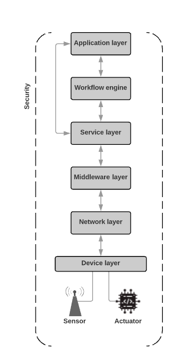How to architect the introduction of IoT technology to businesses?
How to architect the introduction of IoT technology to businesses?
Modern-day organisations require their business processes (BPs) to be agile, adaptive and flexible.
A BP can be defined as “a collection of related events, activities, and decisions that involve a number of actors and resources and that collectively lead to an outcome that is of value for an organization or a customer” (Dumas, La Rosa, Mendling, & Reijers, 2013)[1]. Having a business process architecture (BPA) in place provides guidance for the actual modelling of the involved business processes and assures a consistent and integrated collection of process models with the aim to optimize the value creation across the value chain (Dijkman, Vanderfeesten, & Reijers, 2011). Future BPs are anticipated to be oriented on ensuring intelligence and actionable knowledge in real time for the manufacturing process and all elements participating in the value chain. BPs require valuable information whilst being executed in order to make meaningful decisions. This information can be provided by the Internet of Things (IoT).
IoT allows smart devices, i.e. capable of sensing, identifying, processing, communicating and networking, to be sharing data over a network, i.e. the Internet. In the near future a wide application of IoT to industries is expected due to the rapid advances in technology and industrial infrastructure (Xu, He, & Li, 2014). Sensing and perceiving of the process environment are the fundamental tasks of IoT. With emerging wireless sensory technologies, the concept of IoT goes beyond these capabilities and extends to ambient intelligence and autonomous control (Li, Xu, & Zhao, 2015). Sensor data must be aggregated, interpreted and made available to the Business Process Management System (BPMS) in order to trigger BP activities or human tasks (Schönig, Ackermann, Jablonski, & Ermer, 2018). The insights emerging from using the collected data from smart BP actors allow to facilitate advances in operations and customer services through machine failure prevention, real-time production performance improvement, etc. (Breivold, 2017). In other words, IoT sensors improve BPs with real-time information provisioning, while simultaneously BPs enact the IoT actuators to physically impact the process environment, which ultimately can lead to fully automated and efficient processes. Therefore, they are inseparable.
Until recently, the aforementioned paradigms were solely viewed upon as atomic domains. However, both fields could considerably benefit when they are combined (Schönig, Ackermann, Jablonski, & Ermer, 2018). By embedding intelligence through IoT and BP management (BPM) technology, this will help businesses to achieve cost savings and efficiency gains (Schönig, Ackermann, Jablonski, & Ermer, 2018). Also, the business world itself acknowledges that IoT yields a salient benefit, which is demonstrated by the increasing involvement of IoT in organisation’s business strategy (Milojevic, 2017). Examples of pioneering industries are manufacturing, transportation and utilities, with anticipated expenditures in 2018 (in USD) of respectively $189 billion, $85 billion and $73 billion (Shirer & Torchia, 2017). In order to successfully combine both fields, an architecture needs to be in place which enables the capabilities of both domains.
With the steadily maturing IoT platforms and the demand for businesses to enhance its operations with this technology, a reference architecture is becoming increasingly relevant for the global implementation of IoT. However, there still is a lack in (reference) architectures to facilitate the execution of IoT-BPs. The objective of this paper was to narrow down the architectural gap for the amalgamation of IoT devices and BPs. This paper provides a review of the state of the art in three domains, being IoTAs, BPAs and IoT-BPAs. This allows researchers to quickly gain insight into the matter and serves as a basis for more elaborate research. From literature, the most prominent reference architectures were selected based on (i) surveys which identified the architectures mostly used as a basis for concrete architectures and (ii) the ease of mapping a concrete architecture on the reference architecture. In addition, the relevant requirements for a reference architecture for IoT-BPs were identified and discussed, also showing how these are addressed in current literature. Next, a reference architecture was built which, in contrast to all other examined architectures, is capable of not only integrating the acquired IoT data into BPs, but also enhancing the system to physically impact the environment by steering actuators.

[1] Complete list of references can be found in full dissertation.









